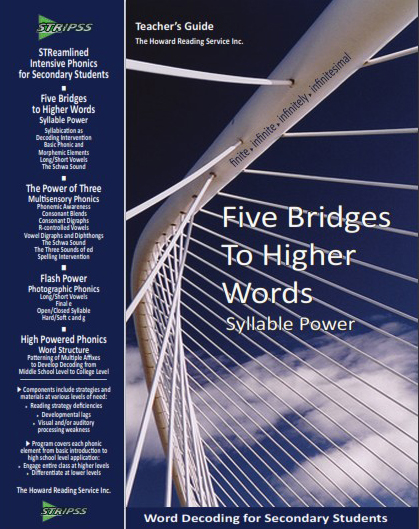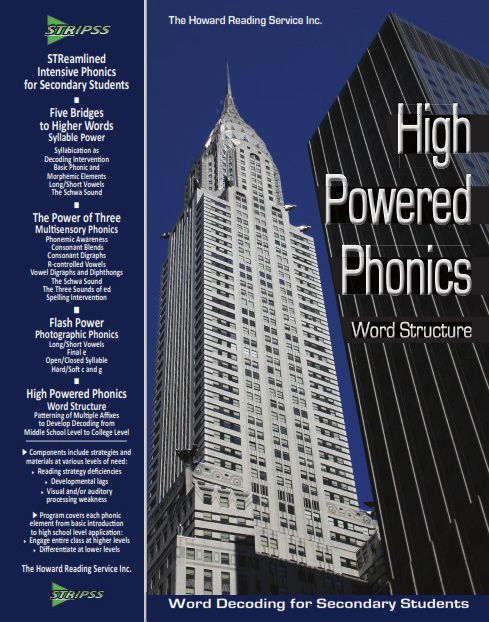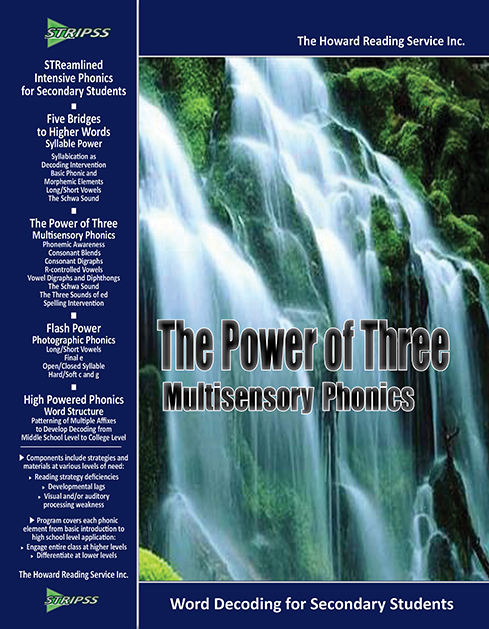Howard Reading Service

Five Bridges to Higher Words, Syllable Power is the main component of STRIPSS, STReamlined Intensive Phonics for Secondary Students.
Since 1986, I have consistently found that about eighty percent of the students struggling to decode words at the secondary level know their phonics but cannot use it because they perceive multisyllabic words as strings of letters.
-Georgia Howard
Five Bridges uses syllabication as a decoding intervention, seamlessly covering basic phonic and morphemic elements within the syllabication lessons.
This program goes beyond “classroom-tested.” It has evolved through twenty plus years of meeting the needs of students and teachers in diverse and numerous reading classrooms at the middle and high school levels, as an intervention teacher, a reading coach, and a mentor to intervention teachers. All of the following essentials for effectiveness are built into this program.
To be effective at any level, a reading intervention program in word decoding must be explicit, carefully sequenced, and multisensory..
To be effective at the secondary level, a phonics program must (1) demonstrate to students recognition and appreciation of their reading strengths while working on their reading weaknesses, (2) include a buy-in for each phonics topic, a discussion or task that shows students what they will gain from these specific lessons and why these lessons will be effective in contrast to their many previous years of phonics lessons, and (3) move at a streamlined pace into grade-level text.
In Five Bridges, a buy-in is presented for each syllable rule and phonics topic. In the very first lesson the students experience success in reading the second longest word in the English language, just by breaking it into syllables. Their enthusiasm in reading this word sets a sense of excitement that is felt by both students and teachers.
Five Bridges is a full-year program. However, throughout the year, only 17 full periods and 26 partial periods need to be planned for the program. Reinforcement and application of the syllabication rules occurs within everyday contextual reading; time for comprehension and vocabulary development is well accommodated.
Students are groomed for successful independent interaction with higher-level text. Lessons utilize a strategy for metacognition. Students are led to consistently reflect on their use of the syllabication process as they write the rule number for each syllable break.
Five Bridges has been constructed to adapt to the range of needs in the secondary classroom. Each phonic element is covered from basic introduction to high school level application. Strategies for more able and less able students are included throughout the pages. The whole class can be engaged in meaningful, growth-effecting multisyllabic word tasks while the needs of the less able students are unobtrusively met.
Five Bridges has both a fully scripted Teacher's Guide and a CD of fully scripted PowerPoint presentations. The Student Booklet is used with either choice of lesson mode. The Timing Blueprint for Lessons, which is included, references each day's lesson to the pages in the Teacher's Guide, the specific PowerPoint slides, and the pages in the Student Booklet.






